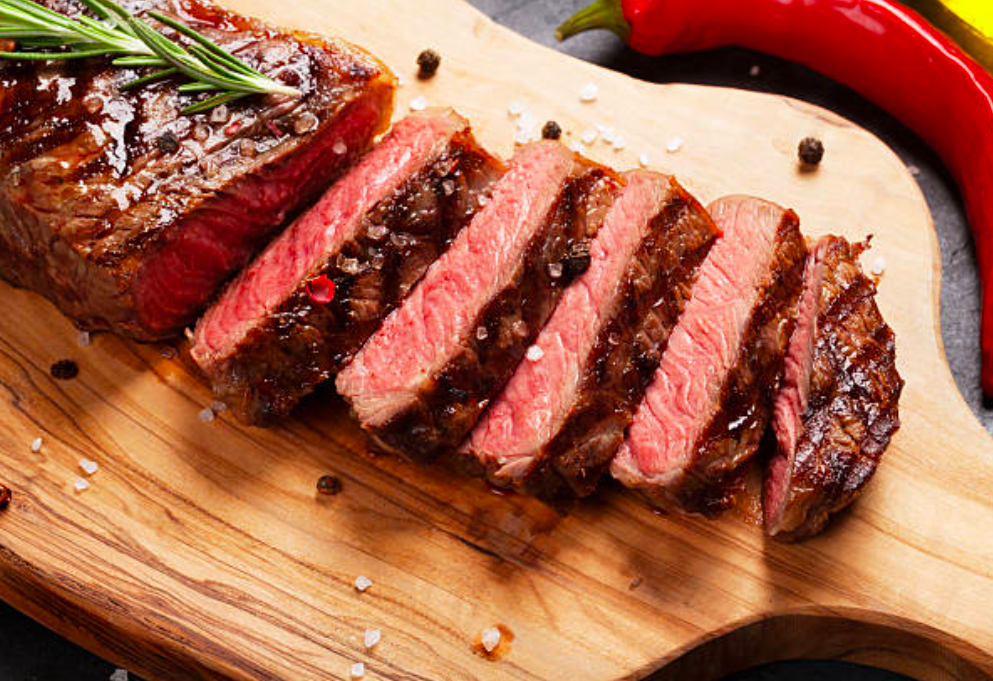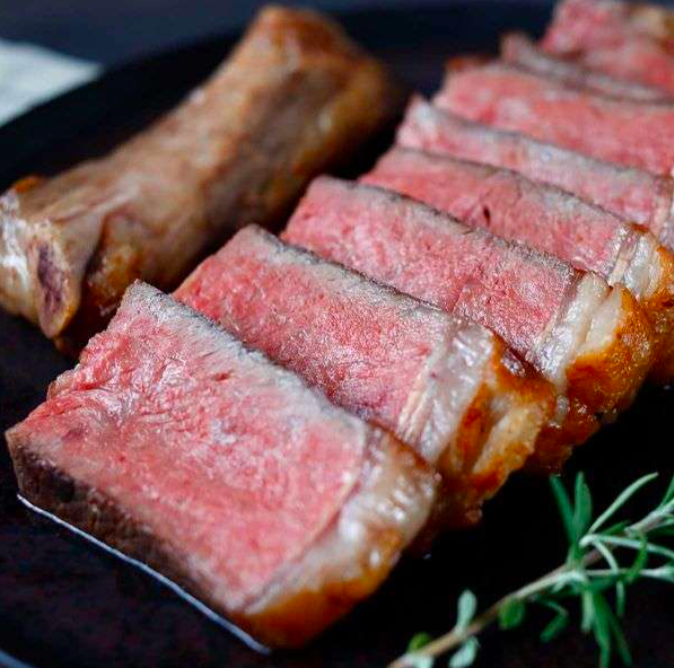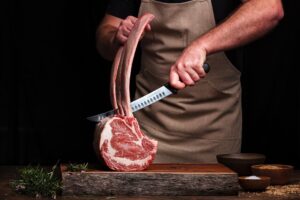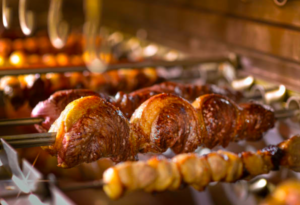Delmonico Steak is a cut of beef fit for royalty. This steak delivers extravagant flavor and tenderness. Situated between the Ribeye and NY Strip Steak, the Delmonico boasts intense marbling that melts during cooking, dissolves into waves of savory bliss with each bite. For an indulgence of only the finest beef, look no further than the illustrious Delmonico.
Table of Contents
What Cut Is a Delmonico Steak?

Delmonico Steak is a premium cut of beef shrouded in mystery. While culinary experts agree on its large size, thickness, and rich marbling, its precise definition remains uncertain. Some consider it a Ribeye, others a New York Strip.
Its name can be dated back to a hundred years ago. Delmonico Steak gets its name from Delmonico’s restaurant in New York City, one of the first American fine dining establishments. Founded in the 1840s, Delmonico’s served a signature steak. As the precise cut is now unknown, its name, “Delmonico,” has been applied to a cut which derives from where the rib and loin primals meet.

Among the butchers, Delmonico is generally considered positioned at the area where the Ribeye ends and the New York Strip begins. And this unique location resulted in a large and flavorful piece of beef with heavy marbling and tender texture.
Due to its richness and desirability, Delmonico Steak is considered a delicacy and commands a high price. With careful cooking, its distinctive marbling allows it to become melt-in-your-mouth tender. Thus, this cut is coveted which fits for special occasions.
► Read More: 8 Primal Cuts of Beef to Learn Before Ordering Steaks
► Read More: 20 Best Steak Cuts Ranked (A Complete Guide to Know Your Cuts)
How Many Delmonico Steaks In a Cow?
The Delmonico is cut from a specific part that is quite large but limited in quantity. There are merely two Delmonico Steaks per cow, one from each side.
This scarcity, aligned with its tenderness and bold flavor, makes for a highly coveted cut of beef certain to delight steak connoisseurs.
How Does Delmonico Steak Taste?

Because the Delmonico Steak is cut from between the Ribeye and New York Strip Steak, it delivers the best of both cuts. It possesses the deep, beefy flavor of the ribeye with rich marbling that renders it exceptionally juicy.
At the same time, it offers the satisfying texture of a strip steak – firm yet tender. Since the Delmonico lacks the wide fat cap of the Ribeye, its texture is more uniform throughout.
The bone-in nature of this cut also allows the meat surrounding the bone to stay juicy and tender, insulated as it is from the direct heat. Overall, the Delmonico provides a rich, delectable flavor and mouthfeel that steak lovers will relish.
► Read More: 5 Best Marbled Steak Cuts Ranked & How to Cook
► Read More: 5 Most Tender Steak Cuts Ranked and How to Cook
Does Delmonico Steak Have Bone?
Delmonico Steak can be cut either with or without the bone. The bone-in Delmonico will have a rib bone attached, while the boneless Delmonico has the rib bone removed.
The bone-in Delmonico may have more flavor from the bone. But the boneless version can be easier to slice and serve. It ultimately comes down to personal preference whether you choose bone-in or boneless Delmonico Steak.
How to Cook Delmonico Steak? (Recipes)
Due to its giant size and thickness, simply searing is quite difficult to control the temperature and doneness, unless you’re a veteran. For newbies, reverse sear and sous vide are good ways to cook thick cuts like Delmonico Steak. Here comes 2 quick recipes for you:

◈ Reverse Searing Delmonico
Reverse searing involves cooking the steak at a lower temperature first to allow it to gently come up to temperature, then searing it at the end to lock in the juices and create a nice browning.
This is beneficial for a thick, marbled steak like the Delmonico, since it allows the fat to render more slowly and evenly. To reverse sear a Delmonico Steak:
- Preheat the oven to 250-275°F.
- Rub the steak with kosher salt, pepper or any seasonings you like.
- Place the steak on a wire rack over a baking sheet. Bake until it reaches an internal temperature that matches your preference by a meat thermometer.
- rare—110°F
- medium-rare—120°F
- medium—130°F
This may take 45-90 minutes depending on the thickness of the steak.
- Remove the steak from the oven and loosely cover with foil. Rest it for 10-15 minutes.
- Heat a tablespoon or two of oil in a cast iron skillet over high heat. Sear until well-browned, about 1-2 minutes per side. This will finish cooking the steak to the proper temperature and create a nice browned crust.
- Remove the steak from the skillet. Let the steak rest for 10-15 minutes before serving to allow the juices to redistribute. Slice against the grain and enjoy!
◈ Sous Vide Delmonico
Sous vide is another excellent method for cooking a Delmonico Steak. It involves sealing the steak in an airtight bag and cooking it in a temperature-controlled water bath.
This allows the steak to be cooked very evenly edge-to-edge and the precise temperature control helps achieve exact doneness every time. Plus, the steak remains very moist and juicy due to the sealed cooking environment.
- Preheat your precision cooker.
- Rub the steak with kosher salt, pepper or any seasonings you like.
- Seal the steak into a bag by food sealer or by water displacement method (place the bag into a water bath, remove excess air and seal).
- Clip the sealed bag into the preheated water bath.
- Sous vide according to the time and temperature below.
- Heat a tablespoon of oil in a cast iron skillet over high heat. Take out the sous vide cooked steak and transfer to the skillet. Sear until well-browned, about 1-2 minutes per side for a nice browned crust. Do not overcook!
- Remove the steak from the skillet and let the steak rest for 10-15 minutes before serving to allow the juices to redistribute. Slice against the grain and enjoy!
Either reverse sear or sous vide would be a great choice for cooking a Delmonico Steak!
► Read More: 10 Best Sous Vide Cooker for 2023 | Immersion Circulator
Should You Marinate Delmonico Steak?
Marinating Delmonico Steak is optional. We usually do not marinate the premium beef cut but it depends on personal preference. Marinades can add more flavor to the meat. Here are some marinade suggestions for Delmonico Steak:
- Red wine marinade: Combine red wine, olive oil, rosemary, garlic, thyme, and black pepper. Marinate the steak for at least 2 hours or up to overnight.
- Lemon herb marinade: Combine lemon juice, olive oil, rosemary, thyme, oregano, and crushed red pepper. Marinate for 2-3 hours.
- Chimichurri marinade: Combine parsley, oregano, garlic, olive oil, and red wine vinegar. Marinate for 1-2 hours. Use the marinade as a sauce after grilling the steak.
- Asian-style marinade: Combine soy sauce, rice wine or sherry, minced ginger and garlic, sesame oil, and red pepper flakes. Marinate for 2-3 hours.
Marinating the steak for too long can lead to a mushy texture, so do not marinate for more than overnight. Be sure to discard the used marinade instead of reusing it. Enjoy your flavorful Delmonico!
Nutrition Facts of Delmonico Steak
4 oz of Delmonico Steak has 261 calories, 22 g of protein, 19.1 g of fat and 85 mg of cholesterol. Different cooking methods will result in different nutrition facts.
Here is the nutrition chart of Delmonico:
| 4 oz of Delmonico Steak | |
| Calories | 261 |
| Carbohydrates | 0 g |
| Protein | 22 g |
| Fat | 19.1 g |
| Cholesterol | 85 mg |
► Read More: 8 Leanest / Healthiest Steak Cuts Best Fit For Weight Loss
Delmonico Steak vs Filet Mignon


Delmonico Steak and Filet Mignon are both extraordinary. So which cut should you choose for your next party? We’ve do some comparisons between these two incredible beef cuts:
First, Delmonico Steak has richer marbling while the Filet Mignon is leaner.
And Delmonico has a robust beefy flavor from the marbling and browning. Filet mignon has a very mild flavor and tender texture.
For the size, Delmonico Steak tends to be larger, thicker, and heavier than Filet Mignon. A single Delmonico can serve four people, while Filet Mignon is usually served individually.
We all care about the price. Delmonico is typically less expensive than Filet Mignon (per unit). However, both are considered premium cuts of beef.
► Read More: 5 Most Expensive Steak Cuts Ranked and How to Cook
In terms of cooking methods, Delmonico Steak and Filet Mignon can both be grilled or pan-seared. Delmonico can handle more aggressive cooking than the leaner Filet Mignon. Also, Delmonico is thicker and better to reverse sear or sous vide it as mentioned on the above.
► Read More: 10 Best Steak Cuts to Grill & How to Grill A Steak?
| Delmonico Steak | Filet Mignon | |
| Marbling | Richer | Leaner |
| Flavor | Robust and Beefy | Mild |
| Size | Larger, Thicker, and Heavier A single Delmonico Steak can serve four people | Smaller Filet mignon is usually served individually |
| Price | Less expensive | More expensive |
| Cooking Method | Can be more aggressive | Less aggressive |
Overall, it depends on whether you prefer more flavor (Delmonico Steak) or tenderness (Filet Mignon). Both are high-quality cuts of beef that are suitable for special occasions.
Summary
Delmonico Steak as a secret premium beef cut, not all steak lovers heard of it or even tasted it. To be a real beef aficionado, you must try it once. Apart from Ribeye and Prime Rib, Delmonico is another good choice for the next celebration party.
► Read More: 11 Secret Beef Cuts that True Beef Lovers Should Know!




